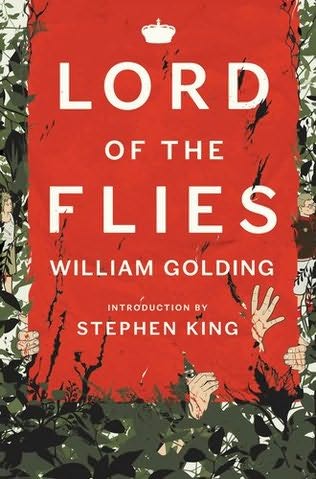Experiential Education and Lord of the Flies
Lord of the Flies, by William Golding

(This image comes from here.)
Mock Trial
There are many reasons to hold a mock trial in a classroom setting, but in the English classroom it can be an incredibly useful opportunity for students to work in groups, speak publicly, understand and identify with characters, and comprehend the text in a larger scope. It is my belief that a mock trial can be done with any grade level, and will can be differentiated for the ability of the students. A mock trial can be held for multiple works of literature. Click here to see books, short stories, and plays that other teachers have used.
Student Quotes about the Mock Trial
"I absolutely LOVED the mock trial. It was a great, fun assessment that really made you think. It was also cool because you could use it with any book, any villain. I really had to think to win the trial!" -Alison
"The mock trial was the highlight of my year in seventh grade. I will remember it until I'm really old, or until I get Alzheimer's."
-Kyle
"I will NEVER forget the mock trial. I lost a lot of sleep and put a lot of blood (figuratively), sweat (sort of figuratively), and tears (literally) into this. I will NOT forget it!" -Morgan
Mock Trial Resources
This is a Web site that I found helpful in planning my mock trial. While the approach they took was more basic than involving the whole class, it did seem effective in engaging tenth grade students.
The National High School Mock Trial Championship has a website with resources for teachers who want to hold mock trials in their classrooms, click here.
Also, please SEE MY RESOURCES PAGE to get all the handouts that I created!!
LotF Mock Trial
The mock trial that I created was for seventh grade advanced content students. It was my goal to give each student a role, and therefore an experience, rather than having some students act as attorneys, while the rest sat as the jury. I was fortunate enough to collaborate with some teachers who'd already done a mock trial, and so I was able to create meaningful exercises for each student as we prepared, and implemented the trial.
To introduce the trial I read a press release to the students to make believe that they were in Britain after the boys had arrived from the island. After reading through the press release I explained the different roles that would be available to the students to apply for, and then asked them to give a written explaination of their top three choices. That day I also made sure to send home a letter asking for all the materials that we would need as props in order for our mock trial to be realistic. This letter home asked parents for things like orange coveralls (like those that prisoners wear), handcuffs, detective's badge, gavel, judge's robe, broken glasses, conch pieces, etc.
The next day I told students the roles who they'd be during the trial. I reminded students that some of them would be disappointed, as there can only be one forensic psychologist. I then handed each student their agenda, which would be different depending on their role. This is where the confusion, and the fun began. It's important when preparing for a mock trial that teachers be prepared, organized, and good classroom managers. One thing that I was sure to do was make sure that everyone had a job at all times. What's so fabulous about this experience is that it can be differentiated for each student's ability. Therefore, the more high achieving students were asked to take on the roles of the attorneys, while those who needed a more controlled experience were asked to be character or eyewitnesses.
Another key element in the mock trial that I created was allowing the students to choose what we would hold Jack accountable for. Would it be manslaughter? Theivery? Arson? Attemted murder? Students enjoyed taking control of Jack's charge. This was made even more exciting when we had a lawyer and detective come and talk to us about real life courtroom drama. The students were enthralled! The experiences and memories that were made from this exercise were countless and undeniable.
Using LotF to teach Tone and Mood
It was late one Sunday evening when I was preparing to read through chapter six of Lord of the Flies with my students that I was struck with what I am now refering to as my, "tone and mood epiphany." Students don't get tone and mood. It's an abstract concept that needs to be explained by an experience. As I was re-reading chapter six I couldn't help but think to myself, what better way to help my students understand what's taking place in chapter six than by helping them to experience it. And so, I set about the task of creating a terrifying mood in the classroom for my students to experience the reading of chapter six.
Instead of welcoming students into the classroom with the door wide open, I had the door closed with a sign taped to the door that read, "Please be seated. I will be with you momentarily. Keep your voices down." I thought of doing this so that I could control when the students would walk into the room, so as to minimize the disruption once they came in, and so as to build some anticipation. My students had no idea what was going on! While the students gathered I watched from the window in the door until they were all there, then went out into the hallway, asked them to leave their bags in the hall, and follow me at their own risk.
When students came into the room they were greeted by pitch black and scary music. Students stumbled to their seats, some giggling, which can only be expected from middle school students, until it was silent. When it became eerily quiet I turned up the volume of the music, which had some screaming, and let it run for about one minute. I noticed some students got really uncomfortale during this part. I then shut off the music and began to read chapter six by flashlight.
I didn't ask students to respond to the mood of the classroom until the next class period. Students were then asked to give a written response to their impressions of Golding's novel thus far. Many of the students said things like, "This story was really boring until yesturday. Now I know something good is about to happen!"
After their own reflection we began our discussion about tone and mood. I led the students on some close reading exercises, helping them to identify tonal words that Golding uses, then we went onto a discussion of tone and mood in cinema. The handout and activity that I created is included on the resource page (all the video clips that are referenced can be found on teachertube.com). I will say that it was incredibly motivating to students to allow them to experience their own dramatic moment from Golding's novel, even if it was simply my interpretation. It also helped them to stay engaged as they were beginning to become lost in Golding's language.


